This was published 3 years ago
Coronavirus (COVID-19) and travel: 15 images that defined travel in a pandemic
By Anthony Dennis
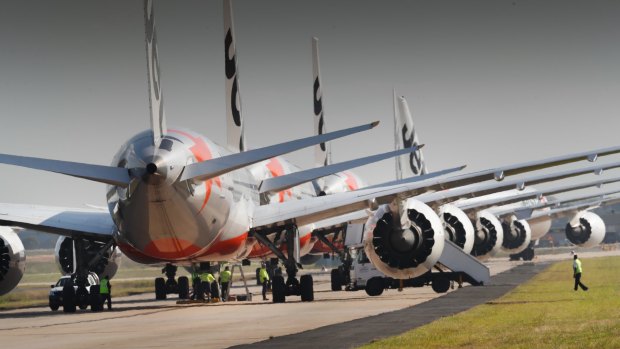
Grounded Jetstar planes parked at Avalon Airport.Credit: Jason South
If one picture paints a thousand words in the midst of a pandemic, these indelible images convey a million. There is surely no more potent way to illustrate the colossal impact of COVID-19 on tourism and travel - one of the most severely affected parts of the global economy - than to highlight the images that have and will define it.
There will be more to come, but for now Traveller has collected 15 unforgettable photographs which depict the historic upheaval in the world of travel over the past dramatic, and at times despairing, 100 days or so.
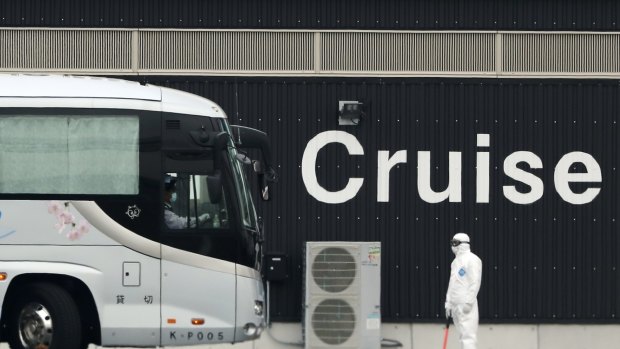
Credit: AP
DATELINE February 20, Yokohama, Japan
THE IMAGE A coach carrying passengers from the quarantined Diamond Princess cruise ship prepares to leave a wharf in Yokohama, near Tokyo.
THE CONTEXT The Diamond Princess was the first cruise ship to alert the world to the exquisite vulnerability of such vessels to the spread of the new and devastating coronavirus. But the warning was not fully heeded as cruise ships continued to sail until well into March, resulting in the Ruby Princess disaster in Australia. Ultimately, the cruises by the two ships would lead to 36 deaths among passengers and crew from COVID-19, surpassing even the 2012 Costa Concordia catastrophe which saw the loss of 32 lives.
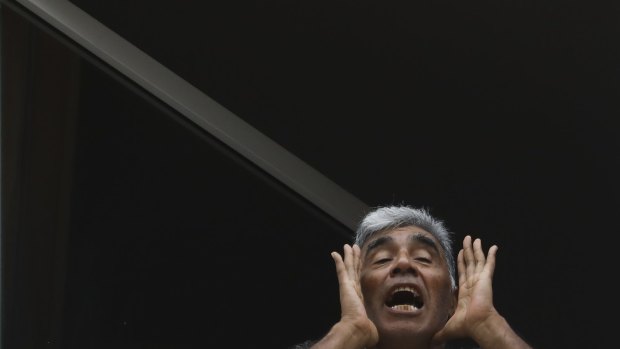
Credit: AP
DATELINE April 1, Buenos Aires, Argentina
THE IMAGE From the balcony of his Buenos Aires hotel room, Marcelo Gomez shouts to the media his complaints about the perceived poor living conditions where he is being quarantined by the Argentinian government.
THE CONTEXT By this time authorities around the world, including those in Australia, had turned to hotels, left empty of more conventional guests, by bans on travel, as venues for the quarantining of returning travellers. The early guests of such programs did not respond well to being confined to four walls for a mandatory fortnight with indifferent meals usually prepared not by hotel chefs but by off-site caterers more accustomed to preparing airline meals.
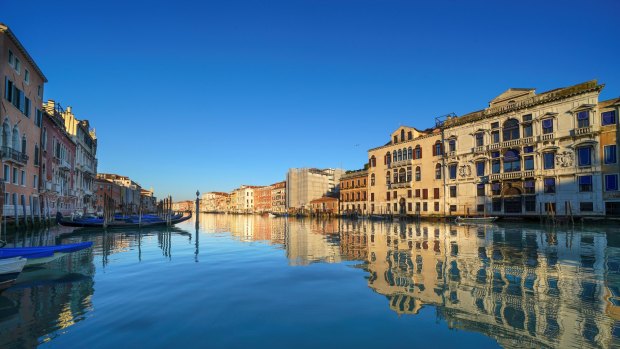
Credit: Images
DATELINE April 9, Venice, Italy
THE IMAGE The ornate facades of Venice's distinctive palazzo are reflected in the unusually calm waters of the Grand Canal during the coronavirus lockdown.
THE CONTEXT Few, if any cities, symbolised the rapid transition triggered by the pandemic from twin scourges of overtourism to undertourism than La Serenissima. Although the glaring absence of tourists was welcomed by Venetians and many concerned admirers around the world Venice and its famed watery main thoroughfare, in reality, was always built for people. In the 16th century, for example, more than 10,000 gondolas took to the famed canals of the city. Before the pandemic struck there were only a few hundred of the craft, which date to the 11th century, remaining.
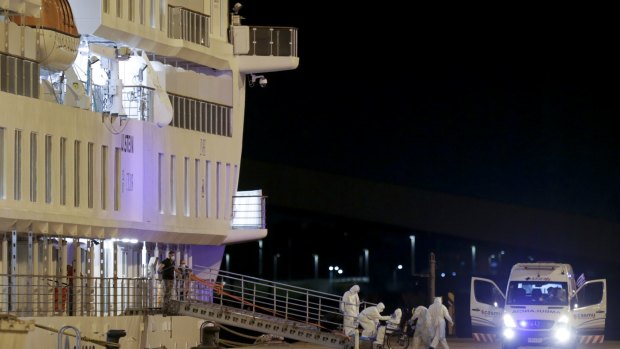
DATELINE April 11, Montevideo, Uruguay
THE IMAGE In a carefully coordinated operation by authorities, a passenger infected with the coronavirus disembarks from the controversial Australian-owned cruise ship the Greg Mortimer, at the port in Montevideo, Uruguay.
THE CONTEXT Once the effects of the pandemic escalated, countries such as Chile and Argentina began closing their borders and turning away cruise ships that only a few weeks before had been routinely and happily accepted to ports. It was left to a heroic Uruguay to rescue the passengers of stranded cruise ships such as the Greg Mortimer, which had been anchored off the South American nation's coast since March 27, with a large number of its passengers and crew infected with COVID-19.
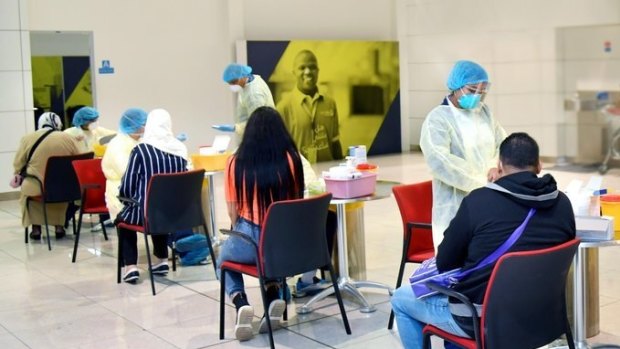
April 19, Dubai International Airport, United Arab Emirates
THE IMAGE Emirates passengers undergo 10-minute coronavirus finger-prick tests conducted by the Dubai Health Authority at Dubai International airport.
THE CONTEXT Confronted by the challenges of continuing to operate in a pandemic, sans a vaccine, airlines have already explored a number of ways to do so, including testing of passengers for COVID-19 before they fly. However, such less-than-reliable tests proved not to be a solution with airlines turning to more conventional means to offer some semblance of safety and confidence of passengers such as the humble facial mask (see below).
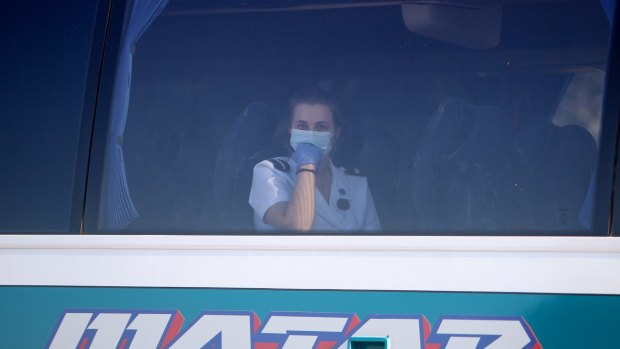
DATELINE April 22, Port Kembla, NSW
THE IMAGE A member of the Ruby Princess crew aboard a coach transferring its passengers for repatriation to the home nations.
THE CONTEXT Not all of the crews of the ship were as fortunate as this colleague. The majority of those crew members are from poorer nations such as the Philippines, Indonesia and India. Months later, in a forgotten humanitarian sequel to the COVID-19 catastrophe that stalled the cruise industry, tens of thousands were still confined to their ships as they awaited approval of the governments to return home.
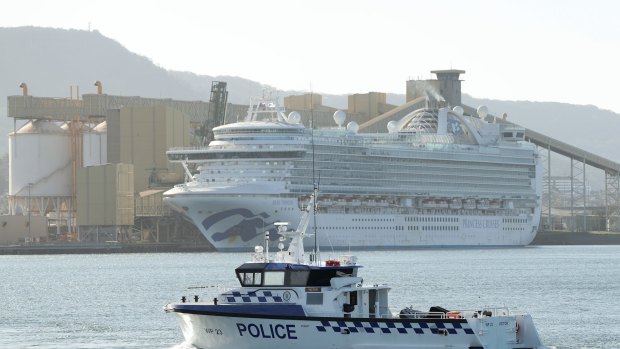
April 23, Port Kembla, NSW
THE IMAGE In a major police operation, the ill-fated Ruby Princess departs Port Kembla Harbour where it had been transferred from the Overseas Passenger Terminal in Sydney Harbour a month or so before.
THE CONTEXT The departure of the Ruby Princess from Australian waters marked the next stage of the ship's COVID-19 saga. But it was not the end of the story for the cruise ship's crew and passengers with a Special Commission of Inquiry convened by the NSW Government into what led to the deaths of nearly two dozen people aboard the vessel. The much-awaited findings from the inquiry into who was responsible for the disaster are due to be handed down in Sydney on August 14.
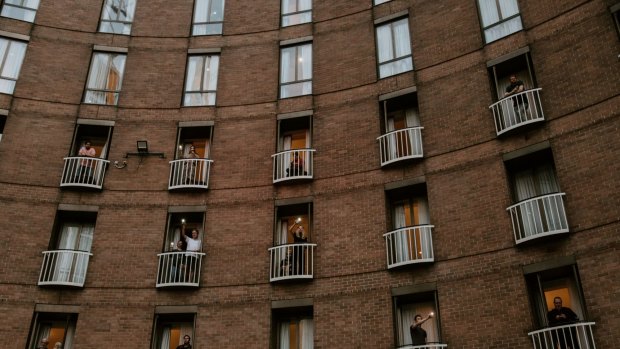
April 23, Sydney, NSW
THE IMAGE The Sofitel Sydney Wentworth hotels hosts a free live music performance, including an appearance by the artist Diesel, in its outdoor garden terrace for the hotel's 400 in-house quarantine guests who enjoy the sounds from their room balconies.
THE CONTEXT Many of the guests on this April evening were celebrating the completion of their fortnight-long mandatory isolation, with 55 of them set to check out of the hotel that day. Unlike the unfortunate events in Victoria, NSW's hotel quarantine program has been a success with thousands of returning travellers billeted at the city's hotels watched over by the state's constabulary and military personnel.
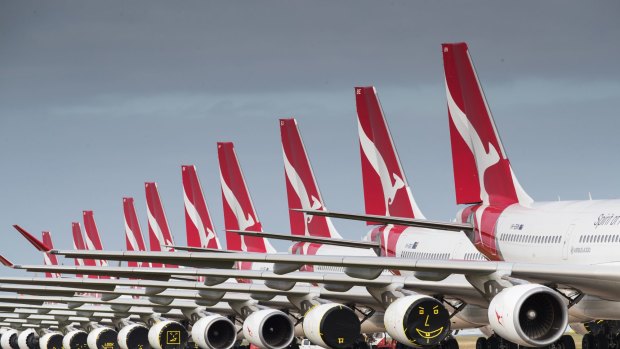
Credit: Jason South
DATELINE April 27, Avalon Airport, VIC
THE IMAGE Qantas and Jetstar planes grounded at Avalon Airport.
THE CONTEXT Not since the September 11 terrorist assault on the US, focused on New York's Twin Towers and Washington DC's Pentagon, have so many of the world's aircraft been grounded simultaneously. With the declaration of the pandemic, airlines scrambled to find space to indefinitely park their fleets with Avalon Airport, near Geelong, south-west of Melbourne, one of the major recipients. Qantas even took the opportunity to permanently park several of the workhorse Boeing 747s further afield in the deserts of the US.
See also: Photos: Thousands of planes grounded around the world
THE IMAGE Young airline passengers, well-protected by both clear face screens and masks are pictured at the Thai capital's second airport as Thai AirAsia and Thai Lion Air resume flights on domestic routes after the COVID-19 halt.
THE CONTEXT Although Australian airline passengers curiously aren't compelled by health authorities to wear facial masks on domestic flights, elsewhere, in countries such as the US, airlines are now insisting on the donning of them to prevent the spread of COVID-19 as well as to promote a degree of reassurance. That is easier said than done in a nation where many US citizens view the wearing of a mask as an assault on their constitutional freedoms.
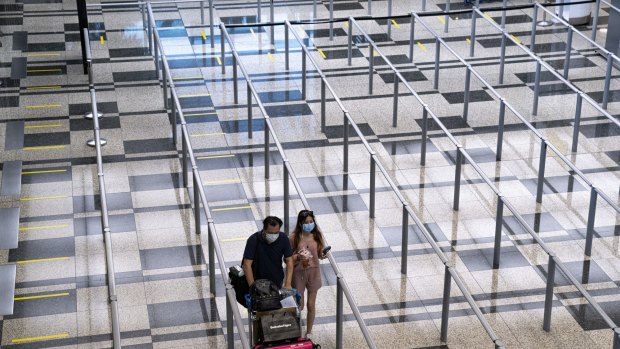
Credit: Getty Images
DATELINE May 11, Changi International Airport, Singapore
THE IMAGE An arriving couple wearing face masks move towards a deserted airport taxi stand at the Changi Airport.
THE CONTEXT Once bustling, 24-hour, multi-terminal airports such as the lauded Changi were rendered ghost towns as worldwide travel bans took effect. Deprived not merely of flights but retail revenue, airports are already one of the biggest casualties of the pandemic. Changi's operators have even chosen to mothball an entire terminal for 18 months, a stark indication of how long it will take for overseas travel to even partially resume.
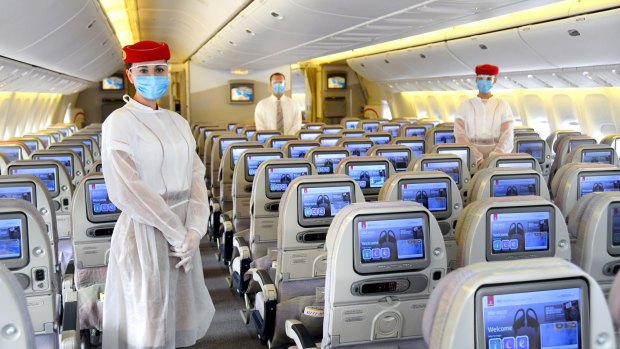
May 15, aboard an Emirates aircraft
THE IMAGE Emirates cabin crew, including flight attendants and ground staff, are clad in personal protective equipment (PPE) gear to guard against COVID-19.
THE CONTEXT They're the new faces of air travel. The flights that were still operating overseas began to take on a distinct, and sometimes disconcerting medical flavour as cabin crew donned protective gear and offered limited onboard service. But the safety measures begin well before takeoff with passengers required to pass through "fever detection scanners" after which they're given "a travel hygiene kit" containing rubber gloves, a face mask, antibacterial wipes and hand sanitiser.
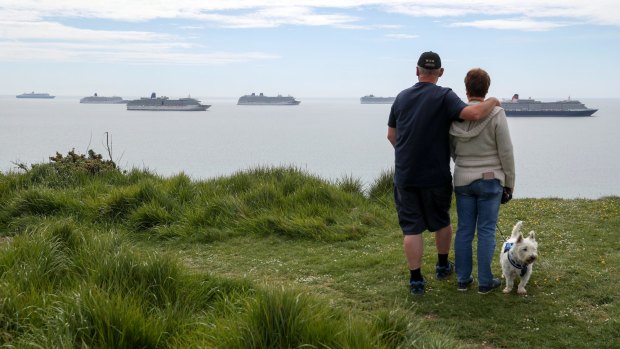
DATELINE May 17, Weymouth Bay, England
THE IMAGE British-registered passenger ships anchor off the coast of England and wait out the protracted ban on cruising.
THE CONTEXT In an illustration of the devastating impact of COVID-19 on the multi-billion dollar cruise industry, Cunard's cruise liners Queen Mary 2 and Queen Victoria, along with P&O cruise ships Aurora, Arcadia, Britannia and Azura are anchored in Weymouth Bay. The scene provides a remarkable spectacle for sightseers on shore but a worrying sight for the owners of the ships with the future viability of the cruise industry still undecided after the last ship sailed with passengers some months ago.
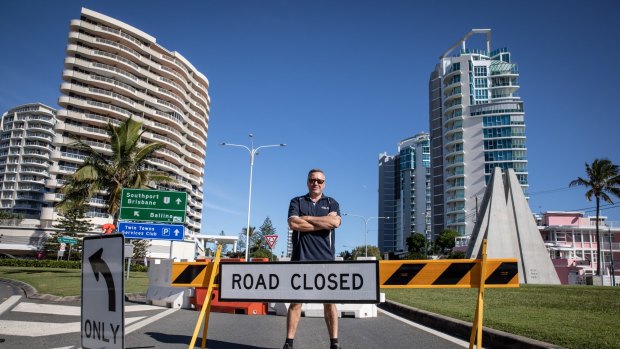
Credit: Paul Harris
DATELINE June 12, Coolangatta, QLD
THE IMAGE Ashley Sartori, owner of Bella Mare Beachside Apartments in Coolangatta, stands behind the historic roadblock at the border closure between Queensland and NSW.
THE CONTEXT It took the second true pandemic in a century for Australian states to close their borders to each other in an effort to contain the spread of COVID-19 (the last time such barriers were erected was during the Spanish flu epidemic between 1918 and 1920). The decision caused havoc and hardship for the nation's tourism industry, particularly operators in Queensland traditionally dependent on tourists from the southern states of NSW and Victoria. Queensland, in a historic move, is poised to reopen its borders to states and territories, bar Victoria, from midday on July 10
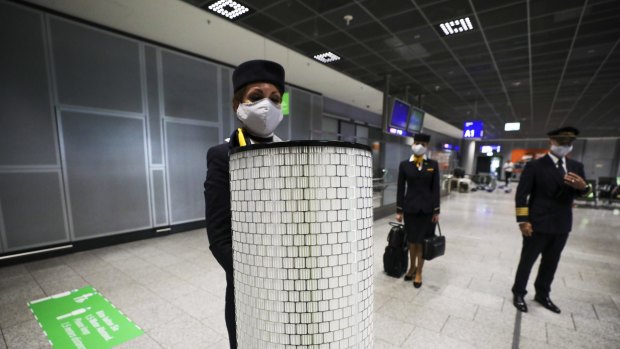
DATELINE June 17, Frankfurt International Airport
THE IMAGE A Lufthansa crew member holds a much-vaunted "high-efficiency" particulate air (HEPA) cabin filter as the airline shows the coronavirus safety measures aboard its aircraft.
THE CONTEXT After having abandoned the concept of social distancing aboard its aircraft due to it being wholly uneconomical, airlines, including Qantas, sought to reassure passengers of the safety of flying during a pandemic. Central to their efforts were hospital-grade HEPA filters designed to trap microscopic particles as small as bacteria and viruses inflight. HEPA filters are said to be effective at capturing greater than 99 percent of the airborne microbes in filtered air. As more passengers return to skies as travel resumes the efficacy of such systems may come under greater scrutiny.
Sign up for the Traveller newsletter
The latest travel news, tips and inspiration delivered to your inbox. Sign up now.